The Intel Broadwell Desktop Review: Core i7-5775C and Core i5-5675C Tested (Part 1)
by Ian Cutress on June 2, 2015 7:45 AM ESTProfessional Performance: Linux
Built around several freely available benchmarks for Linux, Linux-Bench is a project spearheaded by Patrick at ServeTheHome to streamline about a dozen of these tests in a single neat package run via a set of three commands using an Ubuntu 11.04 LiveCD. These tests include fluid dynamics used by NASA, ray-tracing, OpenSSL, molecular modeling, and a scalable data structure server for web deployments. We run Linux-Bench and have chosen to report a select few of the tests that rely on CPU and DRAM speed.
Due to our limited testing time and other issues, only the i7-5775C was processed in our Linux tests. These should be updated for Part 2.
C-Ray: link
C-Ray is a simple ray-tracing program that focuses almost exclusively on processor performance rather than DRAM access. The test in Linux-Bench renders a heavy complex scene offering a large scalable scenario.
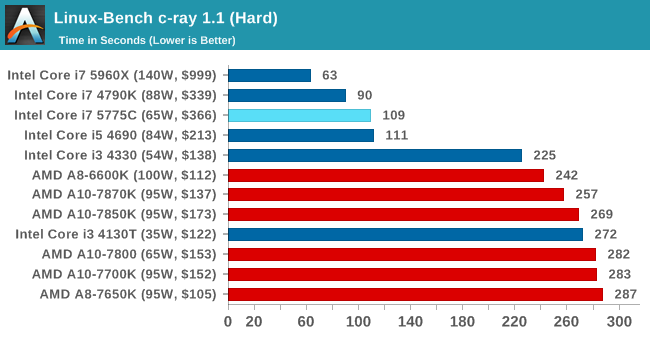
NAMD, Scalable Molecular Dynamics: link
Developed by the Theoretical and Computational Biophysics Group at the University of Illinois at Urbana-Champaign, NAMD is a set of parallel molecular dynamics codes for extreme parallelization up to and beyond 200,000 cores. The reference paper detailing NAMD has over 4000 citations, and our testing runs a small simulation where the calculation steps per unit time is the output vector.
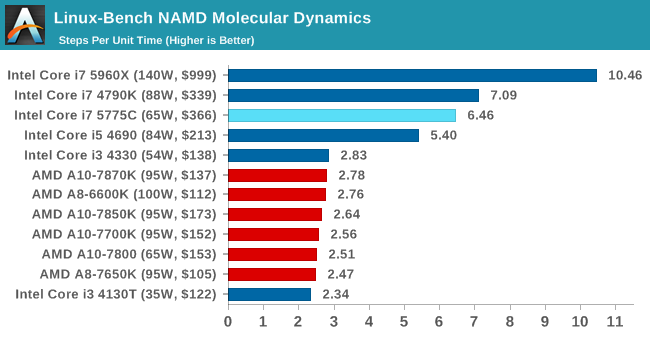
NPB, Fluid Dynamics: link
Aside from LINPACK, there are many other ways to benchmark supercomputers in terms of how effective they are for various types of mathematical processes. The NAS Parallel Benchmarks (NPB) are a set of small programs originally designed for NASA to test their supercomputers in terms of fluid dynamics simulations, useful for airflow reactions and design.
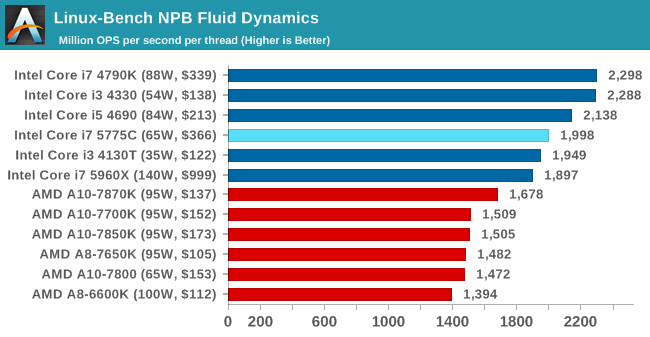
Redis: link
Many of the online applications rely on key-value caches and data structure servers to operate. Redis is an open-source, scalable web technology with a b developer base, but also relies heavily on memory bandwidth as well as CPU performance.
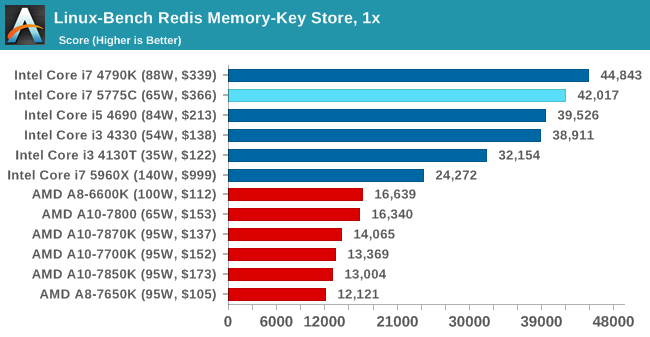
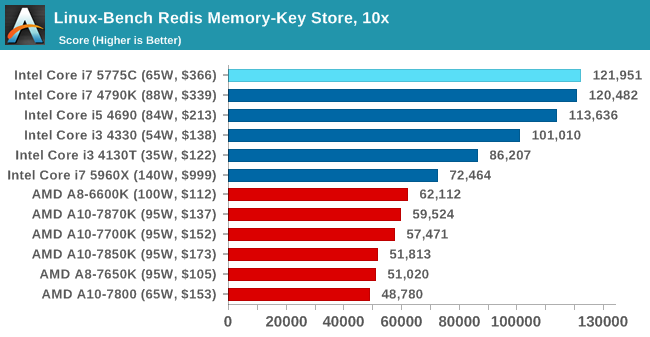
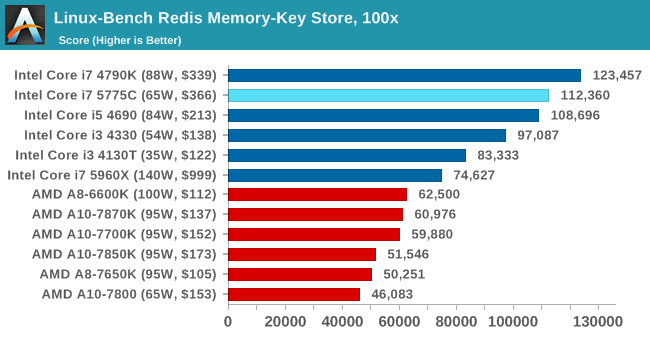










196 Comments
View All Comments
Gothmoth - Tuesday, June 2, 2015 - link
well we can dream.i could use more cores.
i use heavy multithreaded applications and do heavy multitasking.
yet i have to live with 10% better performance per cpu generation. :(
haswell-e is the only choice when i want to upgrade.
but it runs hot and i have no use at all for internal graphics.
so why not making another CPU tailored for people like us?
i mean intel makes enough different CPUs anyway.
Gothmoth - Tuesday, June 2, 2015 - link
ah that reads wrong... i know that haswell-e has no internal graphics.what i meant was... haswell-e runs hot and for the other cpus like broadwell i have no use of the internall GPU.
DCide - Tuesday, June 2, 2015 - link
All this wishful thinking on your part tells me you probably don't have a very strong, actual NEED. Because if you did, you'd be ecstatic about the 5820K or 5960X. They run at 4GHz all day long with standard air cooling and no knowledge of overclocking (I just use ASRock's SLOWEST default overclock settings in the BIOS setup).It's almost humorous when I read these benchmarks, because they so understate the true, completely stable performance of the 5960X without doing any extra work setting it up. It's nearly twice as fast as the 4790K in practice (in fact it *is* about twice as fast when you consider how easily and quickly the 4790K throttles in a typical configuration).
I realize there are situations where generating more heat in the room matters. But if your multitasking were genuinely heavy enough to warrant the upgrade to 6 or 8 cores, you'd be foolish not to take advantage of the great solution that's available right now.
MrSpadge - Tuesday, June 2, 2015 - link
Double the cores means double the power consuption. There's no way around this, except making each core run slower.. which diminishes the benefit of having them. If Haswell-E runs too hot for you, no other chip Intel would reasonably want to produce right now would satisfy you.nikaldro - Tuesday, June 2, 2015 - link
But haswell-E is still on 22nm, not 14nm.nevcairiel - Tuesday, June 2, 2015 - link
Then wait for Broadwell-E.Azurael - Tuesday, June 2, 2015 - link
Why would you want to invest in 3 sticks of DDR4 RAM which will bring nearly no performance benefit and a massively overpriced motherboard for an extra couple of cores? It's not the cost of the Haswell-Es, or even their power consumption that bugs me - I suspect dual channel DDR3 is perfectly adequate for 6 cores alone given that it is apparently adequate for 4+GPU.Still, it makes my investment in a 2500K which has been running at 4.5GHz on stock voltage for the last 3 and a half years on the cheapest Z68 board I could buy sound rather good. I think I'd struggle to gain more than 20% in performance for the outlay of buying a new motherboard and CPU. I built a 4770K-based rig for a friend last year, it won't scrape past 4.2GHz. I'm sure IPC + HT + Faster RAM makes it faster than my rig, but certainly not in any noticeable fashion.
DCide - Tuesday, June 2, 2015 - link
Obviously it wouldn't matter to you. You didn't even bother to go with an i7.But for those to whom it does matter it's the biggest step up we've seen in a desktop CPU in a long time. The additional RAM and motherboard cost is trivial to those for whom the extra performance provides more than amusement.
Azurael - Tuesday, June 2, 2015 - link
You're correct - to me, it seems adequate for video editing and running Android builds... I'm sure in your 'elite' i7 world, things are far quicker. My issue is not with the fact that Intel offers higher spec or more expensive parts. Obviously, there would be no need for 18-core Xeons in this hypothetical world. My issue the fact that they artificially constrain the 'mid' range dual channel architecture to 4 cores and lump us with an IGP that's never going to get used taking up more die space than the extra couple of cores would just because they don't have any competition.Azurael - Tuesday, June 2, 2015 - link
And by the way, a ~84W TDP CPU is going to throttle when overclocked - especially when running AVX loads. If you haven't found the current limits in the BIOS, you probably deserve to believe your expensive 6-core running at only 4GHz is twice as fast as a properly set up 4790K :P